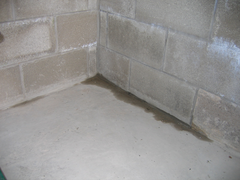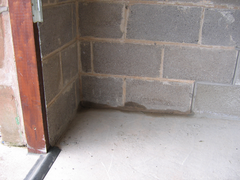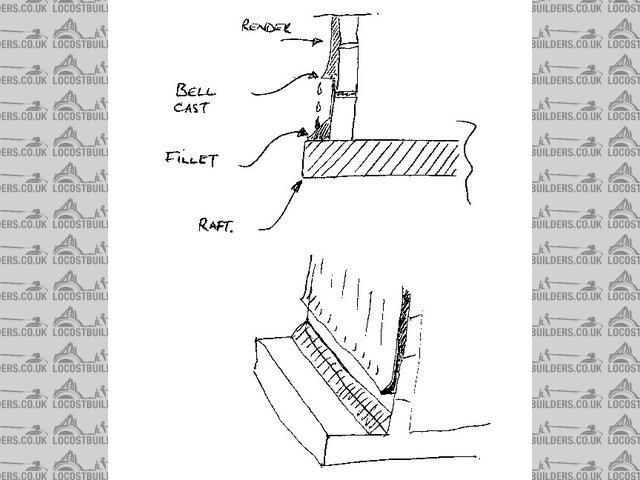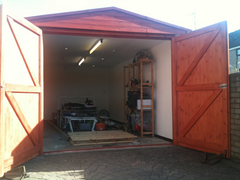RACER101
|
| posted on 2/8/11 at 05:22 PM |

|
|
Garage - Water Ingress - Advice Please
Hello
My garage is built of concrete blocks (cement rendered externally) which have been laid onto a concrete pad.
During heavy rain I find that some water seems to creep under the blocks and into the garage. It looks like the bottom mortar course is acting like a
wick, drawing the water through from outside.
The amount isn't huge but it is annoying and I would like to stop it happening if possible.
 
Description
 
Description
Is there a readily available chemical treatment that I could apply to the bottom layer of blocks & mortar inside the garage which will repel
water?
Any advice or ideas will be very welcome.
Thanks,
John.
|
|
|
|
|
Ben_Copeland
|
| posted on 2/8/11 at 05:34 PM |

|
|
Wheres the damp proof course? its looking as though the outside ground level it the same height as the interior level, which means the damp proof
course is at ground level (which is bad)
If you trap the moisture behind a "treatment" its liable to creep up the wall.
Best would be to tank seal it from Outside, basically rubber membrane round at floor level so water cant come through.
It's all in the building regs book, if you want a scan of the picture...
Ben
Locost Map on Google Maps
Z20LET Astra Turbo, into a Haynes
Roadster
Enter Your Details Here
http://www.facebook.com/EquinoxProducts for all your bodywork needs!
|
|
|
RACER101
|
| posted on 2/8/11 at 06:08 PM |

|
|
Hi Ben
You are right, the exterior and interior levels are the same (built like that by the previous owner) meaning there is no effective damp proof course.
The first layer of blocks have been laid on a piece of dpc material but this is largely ineffective because it is, of course, at the same level as the
floor.
I was hoping that a chemical treatment might be absorbed into/through the blockwork and this would have a 'dual action' preventing any
creep either up the wall or under it.
I agree that tanking from outside would definately be the most effective method but this would be pretty difficult due to access issues
etc...............I was hoping for an easier fix
Thanks,
John
|
|
|
Puzzled
|
| posted on 2/8/11 at 06:28 PM |

|
|
damp
Simple answer ( and the right one), reduce the exterior ground level by 4inches to a width of 3 feet.
|
|
|
Ben_Copeland
|
| posted on 2/8/11 at 06:34 PM |

|
|
There are treatments, but i'm unsure how or if they'll work for this!
Is there no way of dropping the level of the ground from outside?
Ben
Locost Map on Google Maps
Z20LET Astra Turbo, into a Haynes
Roadster
Enter Your Details Here
http://www.facebook.com/EquinoxProducts for all your bodywork needs!
|
|
|
MikeRJ
|
| posted on 2/8/11 at 06:38 PM |

|
|
You could try Thompsons WaterSeal, it does seem to work pretty well on walls, but couldn't say if it will stop ground level damp like that.
It's not that expensive though, so probably worth a go.
Would it be possible to cut a small channel in the concrete slab at the bottom of the wall to collect water? Or perhaps even put some flashing down
to keep water away from the mortar joint at the bottom?
|
|
|
David Jenkins
|
| posted on 2/8/11 at 06:49 PM |

|
|
I remember seeing a Canadian programme on Sky where a bloke fixed peoples' house problems.
In cases where the water table was very high, and the damp-proof course too low (or missing), he would dig a trench around the building, part fill
with gravel, then put a perforated drain pipe around that was linked to the rainwater drainage system, then back-filled with more gravel. I think
that there was also some form of membrane involved too.
Probably overkill for your situation, but maybe a partial implementation would do it, e.g. dig a good-sized trench around and fill with gravel to a
few inches below the line of the garage floor. This should give a bit of clearance to the DPC, plus it would stop water pooling on the outside of the
wall.
|
|
|
thunderace
|
| posted on 2/8/11 at 06:53 PM |

|
|
look up tanking on ebay.
|
|
|
tompat3463
|
| posted on 2/8/11 at 06:59 PM |

|
|
Hi.. Im a builder (ATbuilders) and I deal with this sort of thing all the time... as mentioned above the DPC is at the wrong level.. Dpc on a garage
should be around 225mm higher that the garage door opening..
Obviously U cant cut into our block work and ad a dpc but what U could do with a small expense is.
1. Tank up the inside of ur garaghe about 200mm with black jack and DPM tanking... silver foil stuff that sticks like shit..
lap this on to ur floor about 150mm but DO NOT stick it your floor.
2. Get some Damp proof membrane like Visqueen or similar but a decent gauge.. lay this over your floor and over the top of the flaps of tanking..
this in theory makes the building Damp proof again.. then U would have the task of laying a screed (concrete floor) over the top of ur membrane
again...U could get away with about a 50mm concrete covering in a garage
yeah this is the bit of a task.. but I'd say U could do it for around £150 if that would be ok with U ????
If a jobs worth doing.. Do it right !!!
Cheers Alan
|
|
|
Litemoth
|
| posted on 2/8/11 at 07:17 PM |

|
|
Does the raft (concrete slab) that the walls are sitting on extend outside?...or does it stop flush with the ouside of the walls?
It's not ideal and certainly no substitute for a damp course bit I suggest putting a fillet at the bottom of the wall....use a water proofer in
the cement (Everbuild 202 or SBR for example).#
In conjunction, ensure the render stops short of the floor and has a bell cast to throw the water clear of the bottom of the wall. I would render or
paint a waterproofed slurry to the area inside and out before adding the fillet.
Not ideal but it'll give the water a much harder time getting in. (It seems that the water isn't rising through the raft, simply running
down the wall and wicking actoss at floor level. Not the end of the world.
Ensure everything is sound, clean and not soaking wet before you start work.

[Edited on 2/8/11 by Litemoth]
|
|
|
MikeRJ
|
| posted on 2/8/11 at 08:24 PM |

|
|
I like your picture! Did you do that by hand and scan it in?
|
|
|
RACER101
|
| posted on 2/8/11 at 08:27 PM |

|
|
Thanks everyone for all the ideas and suggestions. I really appreciate you taking the time and trouble to assist  
The concrete raft does extend outside the walls Litemoth, exactly as you describe, so your idea certainly looks workable. The water isn't rising
up through the raft.......it collects on the exterior perimeter of the raft and then creeps through under the blockwork.
Equally good is what you describe Alan (tompat3463).............as you say, if a job is worth doing etc. etc...........and to be honest I can never
really be comfortable with a bodge. This solution might actually be easier for me to do, simply because access to the exterior sides & rear gable
wall is very awkward due to the very close proximity of my neighbours land & my own garden both of which are at a higher level than the concrete
pad (always complications aren't there!). These issues make all the suggested exterior ideas difficult to implement (nothing wrong with the
ideas btw, just I would struggle to put them into practice).
Many thanks again to everyone who made the effort to post. Very generous of you all try and help out 
Cheers,
John
[Edited on 2/8/11 by RACER101]
|
|
|
Litemoth
|
| posted on 2/8/11 at 09:22 PM |

|
|
Chemical solution
LINKY
Fillet compound:
LINKY
My thoughts, for what they're worth, on the screed option would be:
Would 50mm of screed, not bonded to the base, crack?; It's going to be driven on, parked and jacked on etc. Fine in a living room but in a
garage? Maybe a waterproofing/bonding additive would be a better option?
Seems a lot of work for a small amount of water penetration; it's not like the raft is suffering rising damp....
Screeding isn't an amature's job....it needs to be mixed and handled in such a way that it sets as a whole to prevent cracks and mixed so
that it doesn't break up or become dusty......much easier to achive with a wet concrete raft.
...Just trying to give the benefit of things i've learnt the hard way.
|
|
|
Litemoth
|
| posted on 2/8/11 at 09:26 PM |

|
|
quote:
Originally posted by MikeRJ
I like your picture! Did you do that by hand and scan it in?
Thanks!....Yes, it took me about 30 seconds.....paints a thousand words and all that...
|
|
|
tompat3463
|
| posted on 2/8/11 at 09:56 PM |

|
|
50mm of concrete is sufficient for a farage floor.
U could do a wet mix which would be Wat easier to lay and would give a similar finish !
Where u like by the way may be able to come an see.
Cheers alan
|
|
|
Puzzled
|
| posted on 2/8/11 at 11:16 PM |

|
|
Dpc on a garage should be around 225mm higher that the garage door opening..
COMPLETE AND UTTER RUBBISH !!!!!!
|
|
|
Litemoth
|
| posted on 3/8/11 at 10:57 AM |

|
|
quote:
Originally posted by Puzzled
Dpc on a garage should be around 225mm higher that the garage door opening..
COMPLETE AND UTTER RUBBISH !!!!!!
You may disagree (as do I by the way) but I think the spirit of this forum is one of help, support and respect. I think your aggressive and dismissive
tone is somewhat incongruous.
Thanks
|
|
|
b14wrc
|
| posted on 3/8/11 at 11:37 AM |

|
|
Racer 101,
Not sure if you have seen my posts of late, but to maybe give you an idea of what i have done, see the photo below:
 
Description
I actually did all the boarding out in a few months when the weather was dry and hot. Then to my horror i had a few leaks when the rain came. 
So what i have done is painted the fillet that meets the wall and floor with two good coats of Bitumis paint. It rained really badly yesterday and not
a single drop came in. 
Quite pleased with the work so far - just ordered my sockets from screw fix, so tomorrow it should all be wired up.
Ps. Floor is going to be painted red with floor paint once i have built my work bench and cupboards. 
Rob
20vt powered rear engined locost
|
|
|
Litemoth
|
| posted on 3/8/11 at 12:12 PM |

|
|
Blimey!...nice job.
If mine was like that, i'd move in! 
|
|
|
tompat3463
|
| posted on 3/8/11 at 03:40 PM |

|
|
ermmmm......how that rubbish like U tit ??
are U a builder ???
|
|
|
tompat3463
|
| posted on 3/8/11 at 03:45 PM |

|
|
Puzzled...U must be...
when building new house DPC would be at at floor level... correct ???
Now in the rule book says a garage floor should be 225mm below house floor level ??? Correct ???
Hense a continuos DPC around a house and attatched garage would make DPC at garage 225mm about garage door.
People are trying help people on here not trying to proove people wrong U retard..
if 225mm is incorrect that would would be the DPC height for a garage ????
Im spinning on my seat for this answer and explanation U tool !
[Edited on 3/8/11 by tompat3463]
|
|
|
Puzzled
|
| posted on 3/8/11 at 04:12 PM |

|
|
Retard ---- Tit ----- Tool
Keep spinning, . What do you build with ?? Leggo???? I did"nt think they supplied DPC with Leggo !!!!!
You obviously have no idea about good building practices. I do however admire your gall, to call yourself a "Builder".
The world is full of people like you, a hammer ,saw and a shovel , then call yourself an "Expert". What I am ,is no
concern to you, but as can be seen by my posts, I"ve offered sound advice to other forum users in matters relating to
the construction industry. Its a field that I understand and feel qualified to have an opinion on. I, on the other hand
have gained knowledge of mechanics, electrics, and other car related matters by seeking advice from those in the know
, for this I"m very grateful. I think I will let others judge as to MY and YOUR understanding of DAMP PROOF LEVELS ETC
|
|
|
UncleFista
|
| posted on 3/8/11 at 04:58 PM |

|
|
quote:
Originally posted by Puzzled
Retard ---- Tit ----- Tool
What I am ,is no concern to you
No matter, I think we've worked it out 
Tony Bond / UncleFista
Love is like a snowmobile, speeding across the frozen tundra.
Which suddenly flips, pinning you underneath.
At night the ice-weasels come...
|
|
|
tompat3463
|
| posted on 3/8/11 at 05:07 PM |

|
|
still waiting for ur explaination of of which height DPS should be at on a garage !!!!
heres my back up from a well know site !!
In a cavity wall, there is usually a DPC in both the outer and inner wall. In the outer wall it is normally 150-200mm above ground level (the height
of 2-3 brick courses). This allows rain to form puddles and splash up off the ground, without saturating the wall above DPC level. The wall below the
DPC may become saturated in rainy weather. The DPC in the inner wall is usually below floor level, (under a suspended timber floor structure), or,
with a solid concrete floor, it is usually found immediately above the floor slab so that it can be linked to the DPM under the floor slab. This
enables installation of skirting boards above floor level without fear of puncturing it. Alternatively, instead of fitting separate inner and outer
DPCs, it is common in commercial housebuilding to use a one-piece length of rigid plastic, (albeit an angled section), which fits neatly across the
cavity and slots into both walls (a cavity tray). This method requires the need for weep vents to enable rainwater ingress to drain from the cavities
otherwise rising dampness could occur from above the DPC.
http://en.wikipedia.org/wiki/Damp_proofing
......I've been in the trade for 10 years... have a city & guild in level 3 site managment and an AQA advanced construction award....
Ill mail U the certificates if U like....
now...according to that write up on wikipedia..DPC should be 2-3 brick courses above (my 225mm was spot on by the way as 3x75mm is 225mm) ground
level................Just so U've got my point id like to U to point out a garage that has a door opening higher that the garage floor.......
Thats why I called U a retard..Tool...Tit.....now go back U your cowboy builders with Dominic littlewood and study what he and Melinda Messenger say
before U critisize my first hand experience in this matter....
PS.....please give me the dimention of what U would put ur DPC at in ur garage... Ill happilly point out where ur going wrong 
|
|
|
tompat3463
|
| posted on 3/8/11 at 05:08 PM |

|
|
By the way 'Leggo' is 1 G ....... LEGO.....its spelled like that so children can spell it
|
|
|













